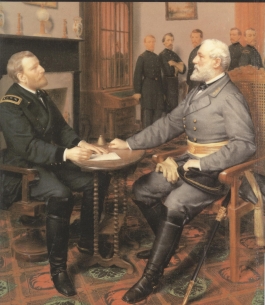 Francis Riker
Francis Riker
 Francis Riker
Francis Riker
2nd Regiment, Pennsylvania Cavalry, 59th Volunteers, Company C
Enlistment Date: 7 February 1865
Side Served: Union
State Served: Pennsylvania

Battles Fought In:
Five Forks on April 1st, 1865
Fought alongside General Philip Sheridan at Appomattox, Virginia on April 8th and 9th,
1865


On the evening of April the 8th, 1865 General Robert E. Lee and the
remnants of his once-proud Army of Northern Virginia arrived in Appomattox County one step
ahead of the pursuing Federal Army. Lee's hope was to reach Appomattox Station on the South
Side Railroad where supply trains awaited.....
Having moved ahead of the rest of Lee's army, General R. Lindsay Walker
led a detachment of reserve artillery to bivouac near the station. It was not long after their
arrival -- around 4:00 -- that Federal cavalry, riding hard from the south, attacked the waiting
supply trains and then assaulted Walker. This cavalry, under command of General Philip Sheridan,
was merely a harbinger of the fast approaching Federal columns. Sheridan's horsemen repelled Walker's
detachment -- Lee's much-coveted supplies were now in enemy hands.
In the meantime, the majority of Lee's forces were setting up a temporary camp
one mile north of Appomattox Court House -- the small town lying between the Confederates and the
station. Word of the victorious Federal advance soon reached the camp. The beleaguered Confederates
realized that Grant's men had the upper hand. A Confederate trooper reflected: "I felt myself now to
be near physical collapse... expecting to go into battle in the morning."
The expectation was validated when, at 2:00 A.M. on the morning of April 9th,
Lee ordered General Gordon's II Corps to move into line of battle west of Appomattox Court House.
Lee had met with Generals Gordon, Longstreet, and his nephew, Gen. Fitzhugh Lee earlier that
evening and decided to throw a portion of his infantry against Sheridan's men. He certainly did
not expect to have to fight Federal infantry, believing that he had outmarched most of Grant's
troops moving west from Farmville.
At 9:00 that morning, Gordon's II Corps was ordered forward to break
through the Federal cavalry and proceed to the west -- in the process recapturing the station.
Protecting Gordon's right flank was Fitzhugh Lee's cavalry. Gordon's Corps, "fought to a frazzle"
during the previous week, was a mere shadow of it's former strength. The combined force of the
infantry and the cavalry numbered no more than 9, 000 men. "Fitz" Lee's cavalry spearheaded the
advance, and the lines of scattered, grey-clad infantrymen lurched forward; most men somnolent from
their early rising yet nervous with the anticipation that manifests itself before an impending
battle. As the line moved up the sloping ridge along the Richmond-Lynchburg Stage road, the enemy
came into view.
Situated on the crest of the hill and beyond were two cannon of Federal
artillery and a brigade of cavalry under General Charles H. Smith. Smith had been ordered by his
division commander, Gen. George Crook, to hold his position as long as possible. The Confederates,
as exhausted as they were, advanced through the artillery and Smith's men fled in their wake --
only to be supported at the last moment by Mackenzie's and Young's cavalry brigades. The combined
force once again slowed the Confederate advance, but most of "Fitz" Lee's cavalry skirted the
Federals and escaped westward toward Lynchburg.
It now became apparent to Gordon that Lee had grossly underestimated the
Federal strength. In truth, Grant had not only positioned more cavalry in front of Lee during the
night, but had also force-marched almost three entire corps of infantry along the South Side
Railroad to arrive at Appomattox Station during the night. Most of the Army of the James (under
Gen. Edward Ord) -- the XXIV and elements of the XXV (United States Colored Troops)-- had moved to
block Lee's western escape route with the Army of the Potomac's V Corps in tow. Gordon and his
battle-worn foot soldiers now faced advancing lines of dark blue-clad Federal infantry -- men of
the XXIV and XXV Corps. As Gordon's men began to skirmish with the Federal Infantry, two Cavalry
divisions converged on the Confederate lines alongside infantry of Griffin's V Corps. It was
only a matter of time before Gordon's men broke. The Confederates withdrew from their advanced
positions and General Lee ordered truce flags sent out at about 11:00 that morning.
Meanwhile, back at his camp, Lee was deep in decision. Not only had Gordon
been defeated to his front, but Federals of the II and VI corps had pinned Longstreet's rearguard
in from the north. Grant had surrounded Lee on three sides, leaving the northwest as his only
unimpeded route. Lee knew that there was no hope of supplying his army by retreating in that
direction. He was in "checkmate": he had no other options left. The disconsolate Lee sent word
to Grant that he was prepared to surrender the Army of Northern Virginia.